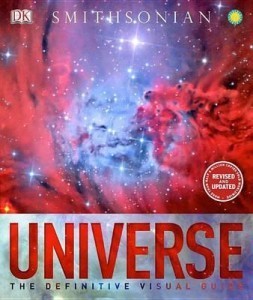Paul Gilster's Blog, page 238
October 30, 2012
Asteroid Deflection: The Paintball Solution
Planetary Resources has us thinking about mining the asteroids to extract useful materials, but learning more about these objects will benefit us in all kinds of ways. Not only do asteroids offer up clues about the early Solar System, but getting to understand their composition and structure will be a key element in any future plans to change an asteroid trajectory. The topic comes to mind periodically as various asteroids make close approaches, and right now I’m looking at asteroid 2012 DA14, which will close to within 22,000 kilometers this coming February.
2012 DA14 is a small asteroid, discovered in early 2012 at the Observatorio Astronómico de La Sagra in Spain, and it is not an impact threat for us next year, although prudence dictates keeping an eye on it for future orbits — the object is recently enough discovered that we’ll need to study it longer to get a better read on future encounters. I see that the University of Central Florida is organizing a viewing party in Orlando on February 15 to track the progress of the asteroid as it zips past us, with Michael A’Hearn, who led the Deep Impact mission, and Harold Reitsema (B612 Foundation) on hand to discuss asteroid research and tracking projects.
Meanwhile, an interesting story comes out of MIT involving a graduate student in the Department of Aeronautics and Astronautics there named Sung Wook Paek, author of a new paper on asteroid deflection. Paek’s notion is that pellets of paint powder launched from a spacecraft close to a problematic asteroid could be used to greatly increase its albedo. The now more reflective asteroid would be nudged off-course slowly but surely by solar photons. All of this would depend on getting to the asteroid long enough in advance to let the method work.
Paek’s work grew out of a call for papers from the United Nations’ Space Generation Advisory Council, whose technical paper competition Paek was able to win, a feat that took him to Naples to present the paper at the International Astronautical Congress in October. The competition was all about new ways of deflecting an asteroid, many of which involved launching a projectile to collide with the object, or setting off a nuclear device near enough to it to disrupt its orbit. We’ve also discussed methods like ‘gravity tractors’ in these pages, where the tiny effects of a spacecraft’s gravitational field work, over time, to draw the asteroid into a new orbit.
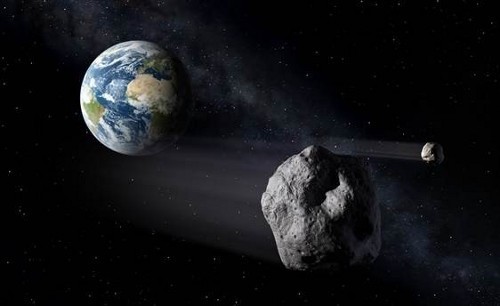
Image: The more methods for asteroid deflection we examine, the larger our toolkit in case we ever do find one on a dangerous course. Credit: GETTY.
In Paek’s method, the paint pellets would contribute their own impact to help bump the asteroid slightly off course, while the paint itself would eventually take advantage of solar photon pressure. Using the asteroid Apophis as his model, Paek calculated that five tons of paint would cover the surface (Apophis is about 450 meters in diameter) in a five-micrometer thick layer. Total time to move the asteroid out of an Earth-bound trajectory: 20 years, highlighting the need to get to such objects as soon as possible. Lindley Johnson, program manager for NASA’s Near Earth Objects Observation Program, calls Paek’s proposal an innovative variation on various methods to use solar radiation pressure. In any case, having a wide range of deflection options is only prudent in the event we ever do discover an asteroid on a truly threatening trajectory.






October 29, 2012
Opening Minds to the Stars
When it comes to experiencing the night sky, there are times when mathematics fades away and poetry comes to the fore. Witness these lines from John Milton’s Paradise Lost:
A broad and ample road, whose dust is gold,
And pavement stars, as stars to thee appear
Seen in the galaxy, that milky way
Which nightly as a circling zone thou seest
Powder’d with stars.
The lines bring back a crisp fall night in the Adirondacks when my wife, my daughter and I were crossing Lake George in a small boat. I’ve seen the Milky Way from many places but never has it seemed so striking as that night, perfectly framed by the surrounding hills, and Milton’s word ‘powder’d’ has the scene exactly right, for the stars seemed like a fine dust interspersed with jewels. The closest photo I’ve seen that captures a scene like this is a spectacular image taken over the snowy cliffs of Creux du Van near Neuchâtel, Switzerland that I found in a new book from the Smithsonian called Universe: The Definitive Visual Guide.
Every year as we start to get into holiday season I look around for a volume something like this. The challenge faced by those of us who try to communicate something of the scale of the universe — the distances between stars and galaxies themselves — is that students don’t leave high school and even college with a real sense of what makes the interstellar void so difficult to cross. Sometimes a well-placed brick of a book laced not only with the best astrophotography but succinct explanations of astronomical phenomena can light a fire in a young mind and awaken awe in the cosmos. Paging through it can also be a useful restorative to anyone’s whose sense of wonder has become jaded.
Martin Rees (University of Cambridge), former president of the Royal Society and now Astronomer Royal, is general editor for this 528 page coffee-table volume, working with a carefully chosen team of writers and astronomers that includes Iain Nicolson, whose 1978 book The Road to the Stars put many of the evolving concepts of interstellar flight in front of the public. Universe works through the basic concepts of astronomy and then moves into a grand tour that encompasses local stars, the Orion Arm and fans out into the galaxy, with an attention to scale that should take the breath of attentive newcomers away when galaxy after galaxy swings into view and the subject turns to clusters of galaxies and their astounding architecture.
Leave this massive but inviting book open in your living room and watch people page through it. The box-like explanations are succinct, just enough to get someone up to speed on red and blue shift, for example, to make sense of Hubble’s findings. The treatment of special and general relativity is compressed into six highly illustrated pages that get across the basic concepts non-mathematically. The text throughout is beautifully supported with diagrams and photography, visual flashcards that invite you to brush up on your facts here and there depending on where you happen to open the book. Thus this about distance considered in terms of the speed of light:
The expansion of space complicates the expression of distances to very remote objects, particularly those that we now observe as they existed more than 5 billion years ago. When astronomers describe the distance to such faraway objects, by convention they use the ‘lookback’ or ‘light-travel-time’ distance. This is the distance that light from the object has travelled through space to reach us today, and it tells us how long ago the light left the object. But because space has expanded in the interim, the distance of the galaxy when the light began its journey towards Earth is less than the lookback distance. Conversely, the true distance to the remote object (called the ‘comoving’ distance) is greater than the lookback distance. These distinctions need to be remembered when, for example, a galaxy is stated as being 10 billion light-years away.
I mention that one in particular because it’s admirably concise and supported with useful artwork on the over-sized pages of this volume, as are so many concepts people acquainted with the field begin to think of as routine but which laymen, coming to them for the first time, can find confusing. Thus current thinking on the Big Bang is beautifully illustrated in ways that give a visual sense for cosmic inflation, the separation of forces, the emergence of matter and the ignition of the first stars. For those with a telescope, a large section on the constellations and a series of sky charts help relate the astrophysical objects under discussion to their place in the night sky.
When I was growing up, the best photography of the heavens was available mostly in black and white images from places like the Palomar Observatory, then working without benefit of adaptive optics. The space-based telescopes whose work graces these pages were obviously not available then. I still have many books from the time and remember how those images thrilled me. Today, a glance at a double-page spread of the ‘Pillars of Creation’ in the Eagle Nebula or the almost surreal beauty of the globular cluster M9 as seen from space could easily turn a young person with a science fictional bent — or perhaps a poet — toward a career actively pursuing deep space topics. This lovely volume should wind up as a carefully placed holiday gift, assuming that you, as do I, have a particular relative or friend whose eyes are begging to be opened to the stars.






October 26, 2012
SETI: Rummaging in the Data
Astronomy is moving at a clip that sees more data accumulated than can possibly be examined at the time they’re collected. We’re creating vast storehouses of information that can be approached from various angles of study. Now ponder how we might use these data for purposes beyond what they were collected for. In a new paper submitted to the Astronomical Journal, Ermanno Borra (Université Laval, Québec) looks at how standard astronomical spectra — including those already taken — can be used as part of SETI, the Search for Extraterrestrial Intelligence.
Here’s the idea: Suppose somewhere out there a civilization decides to reveal its existence to the rest of the galaxy. These extraterrestrials reason from their own experience of science that an advanced civilization will study the sky and take spectra of astronomical objects. These spectra become the medium upon which the senders impose their signal. At our end, spectroscopic surveys of vast numbers of stars allow us to accumulate data that may contain evidence of an unusual signal, a spectrum deliberately crafted to be so striking that it calls attention to itself.
How to create the signal? Through modulating the spectrum by sending short bursts of laser light, an idea Borra addressed in a 2010 paper, as discussed again in this one:
Borra (2010) shows that periodic time variations of the intensity signal originating from a pulsating source modulate its frequency spectrum with periodic structures. Periodic time variations of the intensity signal originating from a pulsating source with periods between 10-10 and 10-15 seconds would modulate its spectrum with periodic structures detectable in standard astronomical spectra. Periods shorter than 10-10 seconds could be detected in high-resolution spectra. Note that the modulation is rigorously periodic in the frequency units spectrum but not in the wavelength units spectrum.
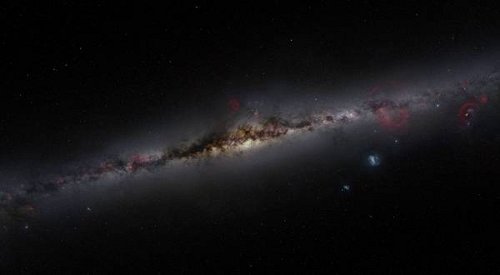
Image: A panoramic image of the Milky Way. Could we use spectroscopic data from surveys already conducted to find evidence of other civilizations? Credit: Photopic Sky Survey.
You can see the beauty of this proposition. We already have mountains of spectroscopic data acquired for other studies, data that can be analyzed visually or through Fourier transform software. Borra wants to make astronomers aware of this potential use for such data as a complement to existing optical SETI work carried out at sites like the Wyeth Telescope (Harvard/Smithsonian Oak Ridge Observatory) and the SERENDIP instrument at UC-Berkeley. The latter are cutting-edge projects, but with some limitations, the biggest being that they can observe only one object at a time. They also require either dedicated instruments or telescope time on standard telescopes, a limitation that a database hunt of earlier work surmounts.
Borra finds that the energy needed to generate the needed signals is feasible even for a civilization like ours — he analyzes it in terms of current equipment by referencing diode-pumped laser technology similar to the Helios laser designed at Lawrence Livermore National Laboratory for inertial confinement fusion studies. The result: An isolated signal transmitted at 1000 light years (a sphere within which there are roughly a million stars) would be detectable with today’s instruments. A spectroscopic survey like the Sloan Digital Sky Survey could find it.
By ‘isolated’ signal, Borra means a signal sent from a place distant enough from the home star so that the signal would not be directly superimposed on the spectrum of the star itself. The other case is a signal sent from the home planet, one that would therefore mix with the stellar spectrum. Now the signal becomes harder to detect because it is considerably weaker than the total energy of the stellar spectrum, requiring the extraterrestrial senders to resort to more powerful sources. Here Borra references the 2004 paper from which he drew the Helios comparisons:
… we can assume that, considering the Moore’s law of laser technology, a more advanced civilization should have no trouble increasing the laser power by 2 to 3 orders magnitude making the signal readily detectable. For a solar-type star at 1000 ly the signal would then be comparable to the stellar background and thus easily detectable… The Moore law suggestion is intuitively justified by simply imagining how Howard et al. (2004) and the present article would have been received before the invention of the laser 60 years ago, when the signal would have had to be generated with light bulbs!
A Kardashev Type I civilization should be able to manage the power output to make its superimposed signal observable at nearby stars, but a Type II would be capable of harnessing all the energies available from its home star, making the production of such signals feasible for vast numbers of potential recipients. Because, as Jill Tarter has often commented, civilizations trying to contact us are likely to be more advanced technologically than we are, the possibility of finding such Type II civilization signals in astronomical spectra becomes an intriguing issue.
What’s appealing about Borra’s approach is its sheer simplicity. The database-mining idea for SETI has a history in the literature going back to papers in 1977 (Zbigniew Paprotny) and 1980 (Daniel Whitmire and David Wright), who suggested searching for anomalous spectral lines originating from radioactive fissile waste material. Geoff Marcy and Amy Reines have carried out a search of 577 nearby stars looking for emission lines too narrow to be natural. Signal-finding algorithms incorporated into existing software can be used with present and future spectroscopic data to continue this hunt, all achieved, as Borra says, with a few lines of code.
Is a SETI signal to be found in our databases? The paper is Borra, “Searching for extraterrestrial intelligence signals in astronomical spectra, including existing data,” accepted for publication by the Astronomical Journal (preprint). Thanks to Antonio Tavani for first calling this one to my attention, and several other readers who also sent in the link.






October 25, 2012
Wanderers Between the Galaxies
The idea of planets outside their normal settings is unsettling. It implies that beyond the stars all around us there may be worlds without suns, dark planets presumably pushed there by gravitational instabilities in their home systems. We’ve looked at such ‘nomad’ worlds before, noting that ice overlaying a frozen ocean might trap enough geothermal heat to create life-sustaining conditions. Estimates on how many such planets might exist vary widely, but in one recent paper Louis Strigari (Stanford University) has calculated that 105 objects larger than Pluto may exist for every main sequence star (see Island-Hopping to the Stars for more on Strigari’s work on free-floating planets). Survey missions like Gaia may help us find some of these.
If a wandering world between the stars is a chilling prospect, what about stars that wander between the galaxies? We have plenty of evidence for their existence. Strip away the emissions from our own Solar System and the Milky Way itself and what you get is the Cosmic InfraRed Background (CIRB), with near-infrared and optical wavelength starlight being redshifted into the infrared, while some of the light is absorbed by dust and re-emitted in the far-infrared. Edward Wright (UCLA) offers up a concise take on the CIRB with photos and a useful diagram.
Early satellites working in the infrared like the Infrared Astronomy Satellite (IRAS) began the modern era of CIRB studies, now being pursued by instruments like the Spitzer Space Telescope. Nature has just published new work from Asantha Cooray (UC-Irvine) and team that uses data from Spitzer to study the infrared background glow, a phenomenon that Cooray says has remained mysterious despite recent studies. Not that it hasn’t spawned theories: Alexander Kashlinsky (NASA GSFC) has argued that the blotchy patterns the infrared glow makes on Spitzer images is coming from the first stars and galaxies. Cooray and company disagree.
Homing in on a section of sky covering an arc equivalent to 50 full Moons — the Boötes field — in a survey that admittedly lacked the sensitivity of Kashlinsky’s data, the Cooray team used their larger-scale study to conclude that the infrared glow is too bright to come from the first galaxies. Instead, they see the light as coming from stars beyond the halos of galaxies, some of them in the spaces between entire galactic clusters. Says Cooray: “A light bulb went off when reading some research papers predicting the existence of diffuse stars. They could explain what we are seeing with Spitzer.”
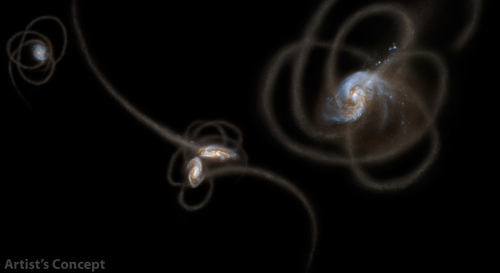
Image: New research from scientists using NASA’s Spitzer Space Telescope suggests that a mysterious infrared glow across our whole sky is coming from stray stars torn from galaxies. When galaxies grow, they merge and become gravitationally tangled in a violent process that results in streams of stars being ripped away from the galaxies. Such streams, called tidal tails, can be seen in this artist’s concept. Scientists say that Spitzer is picking up the collective glow of stars such as these, which linger in the spaces between galaxies. This artwork is adapted, in part, from galaxy images obtained from the NASA/ESA Hubble Space Telescope. Credit: NASA/JPL-Caltech.
The James Webb Space Telescope should help us take this work to the next level, revealing the objects that make up the background infrared light. If Cooray’s team is right, the presence of these lone stars could be accounted for by galactic collisions whose gravitational interactions would propel such stars into the deep. This scenario — and the more gradual absorption of dwarf galaxies by larger neighbors — may thus explain our intergalactic wanderers. Could such stars have intact planetary systems despite the forces applied to them in these interactions?
On such questions hangs not only interesting science but wildly speculative venues for science fiction. The paper is Cooray et al., “Near-infrared background anisotropies from diffuse intrahalo light of galaxies,” published in Nature 494 (2012), pp. 514-516 (abstract / preprint).






October 24, 2012
On Missions and Nearby Stars
Sara Seager’s thoughts on who might join a crew bound for Alpha Centauri have had resonance, as witness Dennis Overbye’s story Discovery Rekindles Wish for a Journey to the Stars in the New York Times. Overbye, a touchstone in science journalism, has probably been pondering the issue because of Seager’s response to his question about Centauri B b. The MIT astronomer laid it out starkly: “I think we should drop everything and send a probe there.”
Seager is well aware of the issues involved and knows what a project it would be to drive a lightsail — or some other kind of spacecraft — up to ten percent of the speed of light. But she has us all thinking about the kind of people who would go on future manned missions (and whether they might wind up changing their minds). Overbye can look back at his high school yearbook, where he finds “Ambition: To go to the stars.” These days he’s thinking more about what would happen if he really did:
Perhaps it is a sign of my age that I think more these days about what I would be leaving behind than what I would be gaining: my family and other loved ones, autumn in the Catskills, one more cowboy trout stream or New Year’s Eve with old friends.

What about Mae Jemison, the former astronaut, engineer and actor who now leads the 100 Year Starship organization? Working with Icarus Interstellar, she landed a DARPA grant for $500,000 to plan for an interstellar mission, and it turns out Centauri B b was announced on her birthday. Thinking about those trout streams and mountain autumns, Overbye asked Jemison if she would want to board a starship, knowing that she could never return. Her response: “Yeah… I would go.” But she was quick to add: “It makes a difference who goes with you.”
Image: 100 Year Starship’s Mae Jemison.
Would we bring enough of our own culture along with us on an interstellar journey to create a truly livable environment aboard the craft? Jemison think so, saying that our ideas about such trips have to be reimagined, but it’s hard to see how any conceivable star journey at 10 percent of lightspeed could be a comfortable experience, though perhaps bearable with some kind of hibernation technologies. Much longer trips are another matter, for a sufficiently advanced civilization could think in terms of gigantic worldships that re-created Earthly habitats and, on millennium-long journeys, supported many generations of spacefaring humans.
Overbye acknowledges that all of this is daydreaming, given the current state of our technology, but sketching out a vision helps us understand the problem and question the tentative solutions. Seager’s enthusiasm for a future probe to Centauri B b reminded me of planet hunter Geoff Marcy (University of California at Berkeley), whose numerous exoplanetary finds include fully 70 out of the first 100 to be identified. It was Sara Seager who urged a 2011 MIT workshop to be provocative, leading Marcy, who was in attendance, to say this about star probes:
“I’d like to make an appeal to President Obama. I think he should stand up and make the following announcement: That before the century is out we will launch a probe to Alpha Centauri, the triple star system, and return pictures of its planets, comets and asteroids, as soon as possible, even if it takes a few hundred years or a thousand years to get there. [Going to Alpha Centauri] would engage the K-12 children, it would engage every sector of our society… It would jolt NASA back to life, if we’re really lucky. And of course any such mission should be an international one involving Japan, China, India, Europe…”
Marcy told the same audience that the key for the future of exoplanet studies was to get spectra of nearby stars. Staying close to home allows us to measure the atmosphere of these exoplanets once we have the space-based instrumentation in place. Moreover, proximity means we’ll be able to distinguish them from the zodiacal dust in their systems because as we study that relatively close dust, we’ll learn how to subtract its signature to resolve any Earth-like worlds more clearly. We need the ability to home in on planets within 25 light years not only for pure science but because these are the planets that, we hope, will be reachable by future propulsion systems.
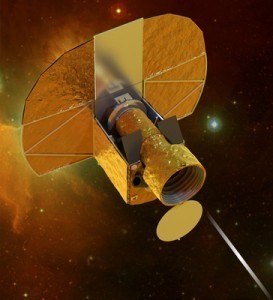
Bear in mind that the 2010 decadal survey New Worlds, New Horizons in Astronomy and Astrophysics made no mention at all of the Terrestrial Planet Finder mission. But just the other day we had news that Cheops had been designated as a new mission by the European Space Agency, with launch expected in 2017. Cheops – for CHaracterising ExOPlanets Satellite – will look at the kind of stars Marcy is talking about, nearby bright stars known to have planets. Hunting for transits, the mission will measure planetary radii and, for planets whose mass is known, reveal their density, which should tell us something about their internal structure.
Image: An artist’s impression of the Cheops telescope. Credit: University of Bonn.
The plan is to operate Cheops in a Sun-synchronous low-Earth orbit at an altitude of 800 kilometers, with a mission lifetime of 3.5 years. Alvaro Giménez-Cañete, ESA Director of Science and Robotic Exploration, says that “By concentrating on specific known exoplanet host stars, Cheops will enable scientists to conduct comparative studies of planets down to the mass of Earth with a precision that simply cannot be achieved from the ground.” We can hope that as more planets are found around nearby stars, other new missions will get funding, and the zeroing out of Terrestrial Planet Finder will one day be seen as only a temporary setback.






October 23, 2012
Deck Hands for a Four Decade Journey
If you were offered a chance to make an interstellar journey, would you take it? How about a garden-variety trip to low-Earth orbit? I’m often asked questions like this when I make presentations to the public, and I have no hesitation in saying no. Though I’m no longer doing any flight instructing, I used to love flying airplanes, but getting into a rocket and being propelled anywhere is not for me. To each his own: I’m fascinated with deep space and hope many humans go there, and you can count on me to write about their missions and robotic ones as well while keeping my office right here on Earth.

The point is, the percentage of people who actually go out and take the incredible journeys and fly the dangerous missions is vanishingly low. But throughout history, there have always been a few intrepid souls who were willing to get into the canoes or the caravels or the biplanes and open up new territories and technologies. Thank God we have the Neil Armstrongs and Sergei Krikalyovs of this world. And somewhere in England there are the relatives of some young 18th Century adventurer who signed up as a cabin boy and wound up living out his life in Australia. People like this drive the species forward and put into action the yearning for exploration I suspect we all share.
Image: Sara Seager, who specializes in exoplanet atmospheres and interiors as the Ellen Swallow Richards Professor of Planetary Science at MIT. Credit: Justin Knight.
I’ve told this story before, but in the past few weeks a high percentage of the people coming to this site are coming for the first time, so I’ll tell it again. Robert Forward was the scientist who more than any other argued that we study methods for reaching the stars, saying that it could be done without violating the laws of physics and would therefore one day occur. Forward’s son Bob told me what happened one night at dinner when he asked his father whether he would get on a starship if it landed nearby and he was asked to go out and explore the universe, with the proviso that he could never come back. Forward’s response was instantaneous: “Of course!”
To which his wife Martha could only reply: “What about us? You mean you would just leave your family and disappear into the universe?” That made Forward pensive for only a moment as he replied, “You have to understand. This is what I have dreamed about all my life.”
MIT’s Sara Seager always manages to work the personal participation question into her talks on exoplanets. She pushes the audience this way and that and it always turns out that there are some people who would go no matter what. Here’s what she told The Atlantic’s Ross Andersen in a recent story, after describing how nuclear pulse propulsion or some kind of sail might conceivably get a spacecraft up to ten percent of lightspeed, which makes for a four-decade journey to the nearest stars:
“…I explain the hazards of living on a spacecraft for 40 years, the fact that life could be extremely tedious, and could possibly even include some kind of induced hibernation. But then I always ask if anyone in the audience would volunteer for a 40+ year journey, and every single time I get a show of hands. And then I say, “Oh I forgot to mention, it’s a one way trip,” and even then I get the same show of hands. This tells me that our drive to explore is so great that if and when engineers succeed at traveling at least 10 percent of the speed of light, there will be people willing to make the journey. It’s just a matter of time.”
I don’t doubt that Seager is right. What she might have gone on to say, if she really wanted to push the point, is that at ten percent of the speed of light, the Alpha Centauri mission that reaches its destination in 43 years is clearly a flyby. Spend more than four decades in transit and then whisk through the target system in less than a day. Would the hands still come up? My guess is that a few still would. A few would probably come up in answer to the question: “Would you go to Alpha Centauri if the only planet in the system turned out to be heat-blasted Centauri B b?” Explorers do this kind of thing — Percy Fawcett didn’t push into the Mato Grosso because he thought it was a clement place to be, nor did Robert Falcon Scott think highly of Antarctic weather.
Seager mentions what Marc Millis always calls the ‘incessant obsolescence’ problem, namely that sending one probe may simply result in its being passed enroute by another probe built later with faster technology. You can keep working that scenario until your head spins (go re-read A. E. van Vogt’s ‘Far Centaurus’ for just one science fictional take on the issue), but waiting for technology to improve gets you nowhere. At some point, you have to launch something, because we learn both through our successes and our failures, and waiting for things to happen can result in stagnation. Pushing the envelope with our crew of hand-raisers is what makes for progress.
Andersen is always a good interviewer, and he homes in on a key issue with regard to interstellar technologies. How do we develop them? Specifically, we would like to wed improved space science to the industries that can benefit from what a space infrastructure can produce, but what kind of industry would benefit from the technologies that can get us to the stars? Noting her belief that the first interstellar missions will be robotic probes, Seager responds:
Right now, I can’t see any connection between capabilities for interstellar travel and industry — at this point, it would purely be for exploration. But we can still benefit if industry decides a low-Earth orbit platform for assembly and launch would be useful. That’s because much of the fuel used for space missions is used to combat Earth’s gravity. If you have a way to assemble these probes in space, you actually have a chance to be more efficient and go faster. It’s conceivable that the private sector would be interested in something like that.
We’re going to be learning a lot more about what the private sector is and isn’t interested in as we experiment with different business models — Planetary Resources comes to mind (Seager serves as an advisor to the company), but ideas for turning a profit in space are hardly limited to asteroid mining. The suspicion here is that we will be unable to get a good read on commercial space interests until we’ve pushed that envelope as well, actually trying mission concepts and business models across a wide front to see what works. But surely Seager is right that low-Earth orbit is a key to the space infrastructure we want to build. Get there, as the saying goes, and you’re halfway to anywhere.






October 19, 2012
Centauri B: Targets and Possibilities
Voyager 1, now 17 light hours from Earth, continues to be my touchstone when asked about getting to Alpha Centauri — and in the last few days, I’ve been asked that question a lot. At 17.1 kilometers per second, Voyager 1 would need 74,000 years to reach the blistering orb we now believe to be orbiting Centauri B. Voyager 1 is not the fastest thing we’ve ever launched — New Horizons at one point in its mission was moving with greater velocity, though no longer, and the Helios II Solar probe, no longer functional, reaches about 70 kilometers per second at perihelion. But Voyager 1 will be our first craft to reach interstellar space, and it continues to be a measure of how frustratingly far even the nearest stars happen to be.
Cautionary notes are needed when a sudden burst of enthusiasm comes to these subjects, as it seems to have done with the discovery of Centauri B b. What we need to avoid, if we’ve got our eyes on long-term prospects and a sustained effort that may take centuries to succeed, is minimizing the challenges of an interstellar journey. Making it sound like a simple extension of existing interplanetary missions would create a public backlash once the real issues become clear. Better to be straightforward, to note the vast energy budget needed by an interstellar mission, the conundrum of propulsion, the breathtaking scope of the distances involved.
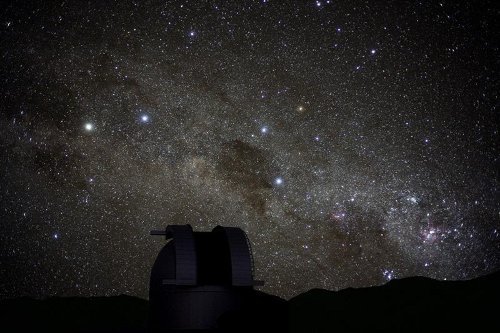
Image: The night sky above Mt. John Observatory in New Zealand, where a second active hunt for Alpha Centauri planets has taken place. This and a third Centauri project, Debra Fischer’s work at the Cerro Tololo Inter-American Observatory (Chile), give us hope that Centauri B b may be confirmed in the near future. Note the Southern Cross (just above and to the right of the dome), with Alpha and Beta Centauri the two stars to its left. Alpha Centauri (the leftmost bright star) is a triple system made up of Centauri A, Centauri B and Proxima Centauri. Credit: Fraser Gunn.
Marc Millis told Alan Boyle just after the Centauri B b discovery that manned missions were almost certainly not going to be our first attempts to reach the stars. We can work out scenarios where the global economy grows to the point where a civilization moving into the Solar System can afford to build huge laser installations that could propel a lightsail to perhaps ten percent of the speed of light. Get up to that kind of velocity and you make the Centauri crossing in less than half a century, but only for a flyby. Deceleration is another matter, and even if, as Robert Forward showed, there may be ways to decelerate a lightsail at destination, the mission then extends to at least a century and, given our assumptions, perhaps a good deal more.
So we’re likely talking about robotic probes which, given the development time needed to create and launch them, would probably be ‘manned’ by an extremely sophisticated artificial intelligence. In the same article, astrobiologist Dirk Schulze-Makuch (Washington State) told Boyle that an interstellar mission could be seen as part of a roadmap that developed incrementally:
“The roadmap that we have takes a grand perspective, with the objective to scout out our own solar system first, put a permanent human presence on Mars, look at asteroids, and really work first on our own solar system before we take the next step to an extrasolar planet.”
And as I’ve speculated here on more than one occasion, a developmental model like this may take a more gentle trajectory than we’ve previously assumed. A civilization that masters living in nearby space by developing large habitats that can house thousands may eventually branch off from its Earthbound human roots to thrive in the places between planets and stars. Generations may indeed live and die in such habitats not because of a specific mission constraint but as a matter of choice. And if this occurs, a mission to a nearby star may be an organic extension of space living, its destination motivated by long-term curiosity rather than any plans of settlement.
Centauri B b is hardly a compelling target for any kind of mission, but the enthusiasm it has already generated points to the latent exploratory impulse that may be triggered if we do find a habitable world somewhere among the Centauri stars. In another recent piece on the discovery, Ian O’Neill quotes Robert Freeland, deputy project leader for Project Icarus, the ongoing re-design of the 1970s Project Daedalus starship study. Like me, Freeland is pondering how the public would react to the next round of Centauri discoveries, assuming such are made:
“I have often imagined the day when scientists directly image an Earth-like extra-solar planet. We would be able to determine the planet’s atmosphere and surface temperature from its spectrum, and we would thus know whether it might be able to sustain life as we know it. I suspect that once such a discovery hits the news, people worldwide are going to demand that we send a probe to determine whether the planet has life (of any type) and/or could be suitable for human habitation. If the latter proves true, then a manned mission would eventually follow.”
A lot can happen, of course, between the surging interest such a discovery would create and the realization of how tough a mission like this would be. But Freeland is surely right that Centauri B b is a warning shot that tells us we’ll be finding much more about this system in the not so distant future. While it is true that the HARPS spectrograph that made the recent discovery possible is capable of detecting planets no smaller than four Earth masses in the habitable zone of Centauri B, Stéphane Udry (Observatoire de Genève) said in the recent news conference that ESO was already working on technologies that would extend that range down to one Earth mass.
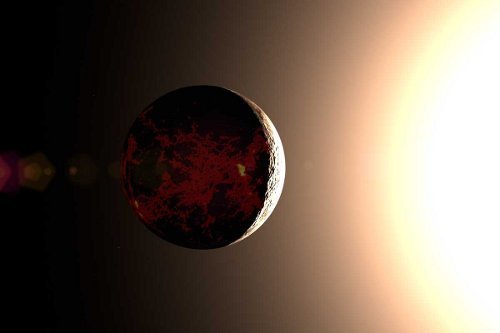
Image: An artist’s impression of Centauri B b. Credit: Adrian Mann.
Meanwhile, supported by the Planetary Society, Debra Fischer (Yale University) has been working on a separate search for Alpha Centauri planets, one she recently discussed with Bruce Betts. Fischer notes how faint the 0.5 m/s signal seen by the Geneva team is and points to the need to confirm the discovery. Her team, which has been talking with the HARPS researchers, has been analyzing its own dataset and running simulations to test detectability. Says Fischer:
“Our best data set for aCenB begins in June 2012, when we completed some stability upgrades to the new spectrograph (CHIRON) that we built for the 1.5-m CTIO telescope (with NSF MRI funding). Our precision since the upgrade matches the HARPS precision, but yields a 5-month string of data compared to the 5-year time baseline of data from HARPS.”
And she adds:
“We are in an excellent position to follow-up, but that will likely require an intensive search over the prospective orbital period of 3.24d when the star rises again in January 2013.”
Would the discovery of a habitable zone planet around Centauri B, perhaps occurring some time in the next ten years, have the effect Freeland believes it would? Given the state of our technology, we couldn’t get off an interstellar mission any time soon, but I would like to think that such a finding would be a spur to research that might turn interstellar studies from a back-burner activity into a more visible and better funded effort. We need to advance the technologies that will help us with in-system projects, from long-term life support to advanced robotics. And we can hope that eventually, a Solar System-wide civilization may emerge that will have the strategies and the energy budget to consider a close-up look at such a distant, tantalizing target.






October 18, 2012
Reflections on Centauri B b
When planet-hunter Greg Laughlin (UC-Santa Cruz) took his turn at the recent press conference announcing the Alpha Centauri B findings, he used the occasion to make a unique visual comparison. One image showed the planet Saturn over the limb of the Moon, as shown immediately below in a 1997 photo from Krzysztof Z. Stanek. Think of this as the Galilean baseline, for when Galileo went to work on the heavens with his first telescope, the Moon was visually close at hand and Saturn a mysterious, blurry object with apparent side-lobes.
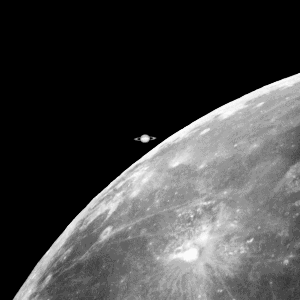
Laughlin contrasted that with the image I ran yesterday, showing the Alpha Centauri stars as viewed from Saturn, a spectacular vista including the planet and the tantalizing stellar neighbors beyond. Four hundred years after Galileo, we thus define what we can do — a probe of Saturn — and we have the image of a much more distant destination we’d like to know a lot more about. The findings of the Geneva team take us a giant step in that direction, revealing a small world of roughly Earth mass in a tight three-day orbit around a star a little smaller and a little more orange than the Sun. What comes next is truly interesting, both for what is implied and for what we are capable of doing.
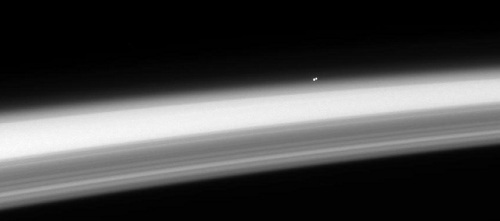
Image: Have another look: Alpha Centauri as seen from Saturn space. These days we can see Saturn’s features in sharp detail thanks to Cassini, but Centauri A and B remain distant and enigmatic. The discovery of Centauri B b is the first step in sharpening our focus. Credit: JPL/NASA.
Be sure to check Alpha Centauri B b on Greg’s systemic blog for his latest thoughts.
Closing on Alpha Centauri
Surprisingly, there is a 10 percent chance that Centauri B b is a transiting world, and a slightly higher chance still if the new planet is in the orbital plane of the binary stars. Remember, the primary Centauri stars are just eleven degrees from being seen edge-on to us. We’re talking about a very challenging detection scenario, but one that’s not out of the question for an instrument like the Hubble Space Telescope. Clearly, a transit would be a major boost, allowing us to determine the radius and the density of the planet (and, obviously, confirming its existence). Stéphane Udry (Observatoire de Genève) told the news conference that a proposal to examine Centauri B for transits has already been sent to the Hubble team.
Radial velocity work on the Centauri stars has proven tricky business, requiring 500 nights of observing time spread over a nine year period. But things are going to get a bit more complicated still, as Laughlin explained in an email on Tuesday. For Centauri A and B are not exactly static, and stray light from the brighter Centauri A can contaminate the studies of B:
I really like the particular way that the narrative is unfolding. The presence of the 3.2-day planet, taken in conjunction with the myriad Kepler candidates and the other results from the HARPS survey, quite clearly points to the possibility, and I would even say the likelihood, of finding additional planets at substantially more clement distances from the star. Alpha Cen A and B, however, are drawing closer together over the next several years, severely metering the rate at which high-precision measurements can be obtained. This builds suspense! It reminds me a bit of a mission like New Horizons, where the long coast to the destination serves to build a groundswell of excitement and momentum for the dramatic close encounter.
At the news conference, Laughlin likened our current state to halftime at a football game. We’ve pulled out a major detection but even as we start to speculate about rocky worlds further out in the system, we’re faced with increasingly difficult observations. We can expect the Alpha Centauri story to unfold slowly, but Xavier Dumusque (Centro de Astrofísica da Universidade do Porto) pointed out how much more difficult it becomes to find planets as we move further out in the Centauri B system, adding that it would take at least twice as many measurements as the Geneva team has now made. Right now the researchers are saying the HARPS spectrograph might be limited to a planet with a lower mass limit of about four Earth masses here, but Stéphane Udry added that new ESO instrumentation was in the works that offered, in the not so distant future, good prospects for finding an Earth-mass planet in the habitable zone.
A 230-day orbit around Centauri B should put us right in the middle of the habitable zone, the place we’d most like to find a terrestrial world. Fortunately, it’s a region of orbital stability — the effects of Centauri A only become problematic as we move as much as 3 AU out from the star. Before we can find a habitable zone planet, we’ll need to confirm Centauri B b and begin to study it, which is where that useful transit could come in. The probable picture is stark — a rocky, lava-world with a surface temperature somewhere around 1500 Kelvin, surely in a tidally locked orbit. Not exactly a clement place, but the implication of other worlds in this system will urge us forward.
Putting the new planet in perspective involves seeing the overall picture of exoplanet research, which could be changed by the discovery. In his email, Laughlin noted the possibilities:
I think that this is important for a society that is increasingly expectant of immediate interactivity and instant gratification… I hope that this detection of Alpha Cen B b provides an impetus for the funding of additional radial velocity infrastructure, and also for space-based missions such as TESS, which can find and study the very best planets orbiting the very nearest stars.
Will the focus now shift from the statistical wonders being revealed by Kepler to the many nearby stars about which we have little planetary information? We saw the other day that the ESA mission concept called NEAT offers new ways to study Alpha Centauri and other nearby stars, and TESS (Transiting Exoplanet Survey Satellite) is likewise out there as a concept that would allow us to survey 2.5 million of the brightest stars in the sky. Data from a mission like this could be handed off to the James Webb Space Telescope for more intense investigation. All that depends on funding and the continued awakening of interest in planets around neighboring stars.
The Choice of Centauri B
We have three stars in the Alpha Centauri system, but Centauri B has been at the center of the current effort, not only by the Geneva team but by Debra Fischer’s team and a third group in New Zealand. Why Centauri B and not its brighter partner, Centauri A? Both could have planets, and in the case of A we can’t rule out planets as large as ten Earth masses (gas giants would probably have been detected by now). What a fascinating scenario that is: Two planetary systems, each with the possibility of a planet in the habitable zone. Imagine the spur to space travel that would give any civilization there, to find a habitable world within easy striking distance!
The focus is on Centauri B because it is a more promising study for the radial velocity methods used in this investigation. Its level of stellar activity is low, which means there are fewer perturbations that can distort radial velocity measurements. It’s also a cooler star than our Sun, which means the habitable zone will be closer to the star than around the brighter Centauri A. Remember that with radial velocity methods we’re looking at incredibly tiny distortions in the movement of the star (in the case of Centauri B b, 51 centimeters per second, or 1.8 kilometers per hour, the highest precision ever achieved using this method). A smaller mass means stronger radial-velocity variation for a planet of similar mass, hence an easier detection.
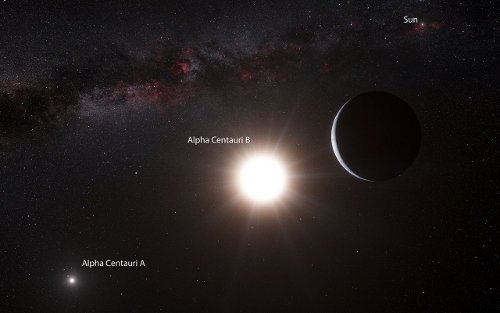
Image: An artist’s impression of the planet orbiting Alpha Centauri B, a member of the triple star system that is the closest to Earth. Alpha Centauri B is the most brilliant object in the sky and the other dazzling object is Alpha Centauri A. Our own Sun is visible to the upper right. The tiny signal of the planet was found with the HARPS spectrograph on the 3.6-metre telescope at ESO’s La Silla Observatory in Chile. Credit: ESO/L. Calçada/N. Risinger (skysurvey.org).
Not that Centauri B is an easy target. There are plenty of factors intrinsic to the star that can introduce jitter in these observations and thus render planet detection difficult. A huge part of the Geneva team’s work has been to examine HARPS spectrograph observations between February 2008 and July 2011 to model and remove all non-planetary sources of perturbation. From the paper:
The raw radial velocities of α Centauri B… exhibit several contributing signals that we could identify. Their origin is associated with instrumental noise, stellar oscillation modes, granulation at the surface of the star, rotational activity, long-term activity induced by a magnetic cycle, the orbital motion of the binary composed of a Centauri A and B, light contamination from a Centauri A, and imprecise stellar coordinates.
Each of these factors had to be modeled and subtracted from the data. The team performed Monte Carlo simulations to check against the signal at 3.236 days being an artifact from the elimination of the stellar signals and was able to conclude that the signal is real. Xavier Dumusque, lead author of the discovery paper, showed the press conference graphs of Centauri B’s magnetic activity, noting that as the latter went up, radial velocity jitter increased. Notice how subtle these effects are and remember that they must be understood to get the real picture:
For the Sun, as for other stars similar to α Centauri B in spectral type, convection induces a blueshift of the stellar spectra. Therefore, no convection means no convective blueshift inside these regions, and so the spectrum of the integrated stellar surface will appear redshifted. Because a redshift means a measured positive radial velocity, a positive correlation between the magnetic cycle variation and the long-term radial velocity variation is then expected.
Get the noise out of the data and that 51 centimeter per second signal persists as Centauri B b.
Significance of the Find
There was a sense of exhilaration in the air on Tuesday as the buzz around an Alpha Centauri planet built, and when the embargo was lifted, reports of the find filled the social media as the early articles began to appear online. Just how big a deal is Centauri B b? A skeptic could point out that while finding an Earth-mass planet is significant, it must still be confirmed, and in any case, this is an Earth-mass planet that is nothing like a clement, habitable world. Then too, the level of investigation involved here was so intense that it may be years before we learn about other planets in this system, not to mention planets around Centauri A or Proxima.
NASA’s John Grunsfeld, Science Mission Directorate Associate Administrator for the agency, had this to say about NASA’s plans in the days after the discovery:
“NASA’s James Webb Space Telescope (JWST) will provide a unique facility that will serve through the next decade as the mainstay for characterization of transiting exoplanets. The main transit studies JWST will be able to undertake are: discovery of unseen planets, determining exoplanet properties like mass, radius, and physical structure, and characterizing exoplanet atmospheres to determine things like their temperature and weather. If there are other planets in the Alpha Centauri system farther from the star, JWST may be able to detect them as well through imaging.
“NASA is also studying two medium-class exoplanet missions in our Explorer program, and in the spring of 2013 will select one of them to enter development for flight later in the decade.”
Clearly the game is afoot. A confirmed Centauri B b would tell us that planet formation is indeed possible in the nearest stellar system to our own — this had by no means been obvious, and the debate over planet formation mechanisms in close binaries has been brisk. The presence of a rocky planet here obviously implies the presence of other worlds, and the Geneva team holds out strong hope that we’re up to the task of finding them. From the paper:
The optimized observational strategy used to monitor α Centauri B is capable of reaching the precision needed to search for habitable super-Earths around solar-type stars using the radial-velocity technique. However, it requires an important investment in observation time, and thus only few targets can be observed over several years. Recent statistical analyses and theoretical models of planetary formation suggest that low-mass rocky planets and especially Earth twins should be common. We are therefore confident that we are on the right path to the discovery of Earth analogues.
Alpha Centauri is obviously a prime target for any future interstellar probe because it is so much closer than other stars. Space-based instrumentation will one day be able to tell us something about the larger Centauri B system, assuming other planets are present. The discovery of a terrestrial world in the habitable zone here would be a spur to exploration that could drive public interest and funding for increasingly sophisticated technologies. Maybe a distant but theoretically reachable green and blue world is out there around our nearest neighbor, but we won’t know until we commit the resources to continue the investigation. Centauri B b is an exciting start to characterizing this fascinating system, a process that will demand time, patience, and effort just as rigorous as the Geneva team put in here. Well done to all involved!






October 16, 2012
Alpha Centauri and the New Astronomy
For much longer than the nine years Centauri Dreams has been in existence, I’ve been waiting for the announcement of a planetary discovery around Centauri B. And I’m delighted to turn the first announcement on this site over to Lee Billings, one of the most gifted science writers of our time (and author of a highly regarded piece on the Centauri stars called The Long Shot). Lee puts the find into the broader context of exoplanet research as we turn our gaze to the nearest stars, those that would be the first targets of any future interstellar probes. On Thursday I’ll follow up with specifics, digging into the discovery paper with more on the planet itself and the reasons why Centauri B was a better target than nearby Centauri A. I’ll also be offering my own take on the significance of the find, which I think is considerable.
by Lee Billings

For much of the past century, astronomy has been consumed by a quest to gaze ever deeper out in space and time, in pursuit of the universe’s fundamental origins and ultimate fate. This Old Astronomy has given us a cosmological creation story, one which tells us we live in but one of innumerable galaxies, each populated with hundreds of billions of stars, all in an expanding, accelerating universe that began 13.7 billion years ago and that may endure eternally. It’s an epic, compelling tale, yet something has been missing: us. Lost somewhere in between the universe’s dawn and destiny, passed over and compressed beyond recognition, is the remarkable fact that 4.5 billion years ago our Sun and its worlds were birthed from stardust, and starlight began incubating the planetary ball of rock and iron we call Earth.
Somehow, life emerged and evolved here, eventually producing human beings, creatures with the intellectual capacity to wonder where they came from and the technological capability to determine where they will go. Uniquely among the worlds in our solar system, the Earth has given birth to life that may before the Sun goes dim reach out to touch the stars. Perhaps, on other worlds circling other suns, other curious minds gaze at their night skies and wonder as we do whether they are alone. In this coming century, a New Astronomy is rising, one that focuses not on the edge of space and the beginning of time but on the nearest stars and the uncharted worlds they likely hold. It will be this New Astronomy, rather than the Old, that will at last complete the quest to place our existence on Earth within a cosmic context.
In a major leap forward in this enterprise, today a European planet-hunting team announced their discovery of an alien world about the same mass as Earth. This alone would be noteworthy, for of all the “exoplanets” now known beyond our solar system, only a very few, and very recently, have been shown to at all resemble our own. But there is more to the story. This particular exoplanet resides in a three-day orbit around the dusky orange star Alpha Centauri B, a member of the Sun’s closest neighboring stellar system. There are two other stars in the system as well, the yellow Sun-like star Alpha Centauri A and the red dwarf star Proxima Centauri.
Astronomers began discovering exoplanets about two decades ago, finding at first a few per year. Since then, the pace of discovery has dramatically accelerated. Today there are more than 750 confirmed exoplanets, and a single NASA mission, the Kepler spacecraft, has detected more than 2,300 additional candidates that await confirmation. Most of these exoplanets are far too large, too hot, or too cold to support life as we know it, but a handful appear to be “Goldilocks” worlds the right size and the right distance from their stars where liquid water could flow in streams and pool in seas, worlds where carbon-based organisms could potentially thrive. The discovery of more Goldilocks worlds appears inevitable — statistics from the Kepler mission and other sources suggest that somewhere between ten to thirty percent of stars harbor potentially habitable planets. Among the planet-hunters, the question is no longer whether life exists elsewhere in the universe, but rather how far removed the next-nearest living world might be.
At a distance of just over 4.3 light years, the stars of Alpha Centauri are only a cosmic stone’s throw away. To reach Alpha Centauri B b, as this new world is called, would require a journey of some 25 trillion miles. For comparison, the next-nearest known exoplanet is a gas giant orbiting the orange star Epsilon Eridani, more than twice as far away. But don’t pack your bags quite yet. With a probable surface temperature well above a thousand degrees Fahrenheit, Alpha Centauri B b is no Goldilocks world. Still, its presence is promising: Planets tend to come in packs, and some theorists had believed no planets at all could form in multi-star systems like Alpha Centauri, which are more common than singleton suns throughout our galaxy. It seems increasingly likely that small planets exist around most if not all stars, near and far alike, and that Alpha Centauri B may possess additional worlds further out in clement, habitable orbits, tantalizingly within reach.
Anyone in the Southern Hemisphere can look up on a clear night and easily see Alpha Centauri — to the naked eye, the three suns merge into one of the brightest stars in Earth’s sky, a single golden point piercing the foot of the constellation Centaurus, a few degrees away from the Southern Cross. In galactic terms, the new planet we’ve found there is so very near our own that its night sky shares most of Earth’s constellations. From the planet’s broiling surface, one could see familiar sights such as the Big Dipper and Orion the Hunter, looking just as they do to our eyes here. One of the few major differences would be in the constellation Cassiopeia, which from Earth appears as a 5-starred “W” in the northern sky. Looking out from Alpha Centauri B b and any other planets in that system, Cassiopeia would gain a sixth star, six times brighter than the other five, becoming not a W but a sinuous snake or a winding river. Cassiopeia’s sixth bright point of light would be our Sun and its entire planetary system.
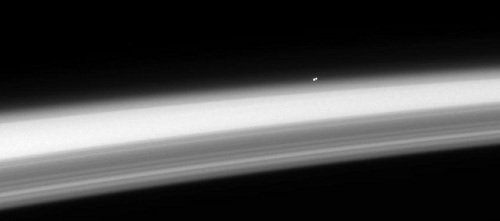
Image: Alpha Centauri as seen by the Cassini orbiter above the limb of Saturn. Credit: NASA/JPL/Space Science Institute.
Despite its close proximity, as with nearly all other known exoplanets, Alpha Centauri B b is as yet unseen. It was detected indirectly, via a periodic 50-centimeter-per-second wobble its orbit raises in the motions of its star, in a painstaking process that took four years of nightly monitoring and careful analysis. The wildly successful Kepler mission finds the bulk of its candidates by a different technique, looking for the minuscule diminution of a star’s light when, by chance, a planet in its orbit transits across the star’s face and casts a shadow toward Earth. Both of these discovery methods can constrain the most basic properties of a planet: its orbit, its mass, and perhaps its size and bulk composition. But neither can readily reveal whether or not any potentially habitable planet is actually a place much like Earth. To do that really requires taking a planet’s picture. Even if that picture amounted to only a meager clump of pixels, astronomers might discern within it a planet’s rotational period — the length of its days — as well as clouds, oceans, and continents. The reflected planetary light would also contain spectroscopic signatures of atmospheric gases. Carbon dioxide would suggest a rocky planet, and water vapor would hint at oceans or seas. Detecting oxygen and methane — gases produced on Earth by living things — would further suggest that the distant planet was not only habitable, but inhabited.
Viewed over interstellar distances in visible light, the Earth is some ten billion times fainter than the Sun, meaning that for every photon bouncing off Earth’s atmosphere or surface, ten billion more are flying out from our star. About the same ratio would apply for any habitable planet around Alpha Centauri’s stars. Distinguishing such faint planetary light from that powerful stellar glare is rather like spotting a firefly hovering a centimeter away from the world’s most powerful spotlight, when the spotlight is in Los Angeles and you are in New York. To see the firefly, that overwhelming ten-billion-to-one background light must be suppressed.
Amazingly, on paper and in laboratory studies, astronomers have already devised multiple ways to do exactly this for potentially Earth-like planets that may exist around nearby stars. Most of these methods require an entirely new multi-billion-dollar space telescope, though a few proposals exist to augment NASA’s upcoming James Webb Space Telescope with starlight-suppressing technology at an estimated cost of $700 million. Considering that three years ago a film about life on Alpha Centauri’s planets — James Cameron’s Avatar — grossed some $2 billion in box-office receipts, it stands to reason there is public appetite to spend at least that much on space telescopes to search for the real thing.
Matt Mountain, the director of the Space Telescope Science Institute in Baltimore, Maryland, likes to quip that the discovery of life beyond our solar system could be to this coming century what Neil Armstrong’s lunar footprints were to the last. Yet today NASA is not seriously funding any life-finding telescopes, and has no real plans to do so in the future. The agency instead is spread thin and lacking any unified direction, strapped for cash and struggling to avoid obsolescence while it maintains the International Space Station, builds a new fleet of rockets to replace the retired Space Shuttles, and completes the James Webb Space Telescope. Yet obsolescence is precisely what NASA will embrace if it fails to invest now in the next giant leap required for this New Astronomy. Of all the scientific institutions and agencies upon this planet, at present NASA alone has the resources to build a telescope capable of directly imaging and characterizing any Earth-like planets around nearby stars. Unless it does so, as the list of potentially habitable planets grows long in years to come, all that shall grow along with it will be our ignorance of what those distant worlds are actually like and what may live upon them.
Meanwhile powerful, influential Old Astronomy, which has revolutionized our understanding of the universe at its largest scales, is wary of the New, and at times has acted quite deliberately against it. Alas, government-funded Big Science is too often a zero-sum game, one in which money that could go toward looking for life on exoplanets around nearby stars would be taken from cosmological efforts to study far-distant galactic clusters and the expansion of the universe. In a perfect world we would fully fund both quests simultaneously. But our world — with its economic instabilities, rising temperatures, growing populations, and plummeting biodiversity — seems to grow more imperfect by the day, in ways that no knowledge of dark energy or dark matter is likely to ever assuage. The New Astronomy is different. We do not yet know whether planets like ours and creatures like us are in fact common or rare in the cosmos, but by trying to find out, we will unavoidably learn just how precious our planet truly is. Perhaps, with luck, discoveries following from today’s announcement will help us finally kick off from our small blue footstool, and find our way among the stars.
Lee Billings is working on a book about the search for other Earth-like planets, forthcoming from Penguin/Current next fall.






Circumbinary Planet in a Four Star System
Continuing with what promises to be a seriously interesting week in exoplanet studies, I want to home in this morning on PH1, a planet that reminds us how much the public has become involved in ongoing science thanks to the widespread distribution of computer power. As presented at the annual meeting of the Division for Planetary Sciences of the American Astronomical Society in Reno (NV), the finding pairs volunteers working with the crowdsourced Planet Hunters project with an international team of professional astronomers led by Yale University’s Meg Schwamb.
The volunteers — Kian Jek of San Francisco, California, and Robert Gagliano of Cottonwood, Arizona — were the first to spot the telltale lightcurve of a transit, which was then confirmed by astronomers using the Keck instruments at Mauna Kea (Hawaii). What the investigation uncovered was a gas giant about 6.2 times the radius of the Earth, putting it into Neptune-territory. But what really flags the attention is the fact that PH1 orbits within a four-star system. The planet is on a circumbinary orbit of two stars — with mass of 1.5 and 0.41 times the Sun respectively — every 138 days. At about 1000 AU in the same system is a second binary pair orbiting the first.
The inner pair comprise an eclipsing binary tagged KIC 4862625, located in the Kepler field and examined by the Planet Hunters duo using the first six quarters of publicly available Kepler data. PH1 is the seventh confirmed transiting circumbinary planet, giving us new information about the orbital configurations of multi-star planetary systems. From the paper:
These planetary systems provide new boundary conditions for planet formation This ever increasing sample of dynamically extreme planetary systems will serve as unique and vital tests of proposed planetesimal formation models and core accretion theories…
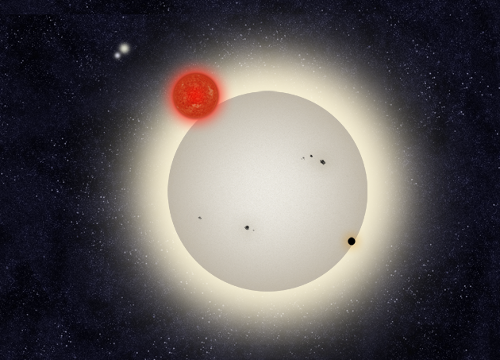
Image: A family portrait of the PH1 planetary system: The newly discovered planet is depicted in this artist’s rendition transiting the larger of the two eclipsing stars it orbits. Off in the distance, well beyond the planet orbit, resides a second pair of stars bound to the planetary system. Credit: Haven Giguere/Yale.
As for Planet Hunters, the Yale researchers believe the ‘citizen science’ model may continue to play a role in gaining new information about such systems:
PH1 was found serendipitously by Planet Hunters volunteers examining the light curves of the known Kepler eclipsing binaries. The discovery of PH1 highlights the potential of visual inspection through crowd sourcing to identify planet transits in eclipsing multistar systems, where the primary and secondary eclipses of host stars make detection challenging compared to planets with single host stars. In particular, Planet Hunters may exploit a niche identifying circumbinary planetary systems where the planet is not sufficiently massive to produce measurable eclipse timing variations that would be identifiable via automatic detection algorithms.
Co-author Jerome Orosz (San Diego State) echoes the sentiment, saying that “Many of the automated techniques used to find interesting features in the Kepler data don’t always work as efficiently as we would like.” Putting many sets of eyes on the data becomes a potent tool when linked up with the professional instrumentation and judgement needed to confirm the find. For more, see this Yale University news release. The paper is Schwamb et al., “Planet Hunters: A Transiting Circumbinary Planet in a Quadruple Star System,” submitted to The Astrophysical Journal (preprint).






Paul Gilster's Blog
- Paul Gilster's profile
- 7 followers


